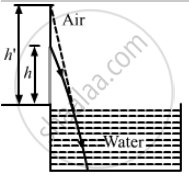Advertisements
Advertisements
प्रश्न
Suppose you are inside the water in a swimming pool near an edge. A friends is standing on the edge. Do you find your friend taller or shorter than his usual height?
उत्तर
When viewed from the water, the friend will seem taller than his usual height.
Let actual height be h and the apparent height be h'.
Here, the refraction is taking place from rarer to denser medium and a virtual image is formed.
Using
\[\frac{\mu_1}{- u} + \frac{\mu_2}{v} = \frac{\mu_2 - \mu_1}{R}\]
Where refractive index of water is μ2 and refractive index of air is μ1.
u and v are object and image distances, respectively.
R is the radius of curvature, here we will take it as ∞.
\[\frac{\mu_1}{- u} + \frac{\mu_2}{v} = \frac{\mu_2 - \mu_1}{\infty}\]
\[\frac{\mu_1}{u} = \frac{\mu_2}{v}\]
\[v = \frac{\mu_2}{\mu_1} \times u\]
We know magnification is given by:
\[m = \frac{v}{u}\]
Putting the value of v in the above equation:
\[m = \frac{u \times \mu_2}{u}\]
\[m = \mu_2 \]
As the magnification is greater than 1, so the apparent height seems to be greater than actual height.
APPEARS IN
संबंधित प्रश्न
Name the phenomenon responsible for it.
Show with the help of a diagram, how unpolarised light from Sun gets linearly polarised by scattering.
Draw the intensity distribution for the fringes produced in interference ?
Draw the intensity distribution for the diffraction bands produced due to single slit ?
Why does the Sun look reddish at sunset or sunrise ?
In the meterbridge experimental set up, shown in the figure, the null point ‘D’ is obtained at a distance of 40 cm from end A of the meterbridge wire. If a resistance of 10Ω is connected in series with R1, null point is obtained at AD = 60 cm. Calculate the values of R1 and R2.
Describe briefly using a diagram how sunlight is polarised ?
A thin lens is made with a material having refractive index
\[\mu = 1 \cdot 5\]. Both the side are convex. It is dipped in water \[\mu = 1 \cdot 33\]. It will behave like
A 1 cm object is placed perpendicular to the principal axis of a convex mirror of focal length 7.5 cm. Find its distance from the mirror if the image formed is 0.6 cm in size.
A candle flame 1.6 cm high is imaged in a ball bearing of diameter 0.4 cm. If the ball bearing is 20 cm away from the flame, find the location and the height of the image.
A biconvex thick lens is constructed with glass (μ = 1.50). Each of the surfaces has a radius of 10 cm and the thickness at the middle is 5 cm. Locate the image of an object placed far away from the lens.
The diameter of the sun is 1.4 × 109 m and its distance from the earth is 1.5 × 1011 m. Find the radius of the image of the sun formed by a lens of focal length 20 cm.
Fill in the blank and rewrite the completed statement:
Very fine particles mainly scatter ______ light.
Explain: ‘How is a rainbow formed’?
Rainbow is the phenomenon due to ______.
State any one difference between a primary rainbow and a secondary rainbow.
| Case study: Mirage in deserts |
 |
|
To a distant observer, the light appears to be coming from somewhere below the ground. The observer naturally assumes that light is being reflected from the ground, say, by a pool of water near the tall object. Such inverted images of distant tall objects cause an optical illusion to the observer. This phenomenon is called mirage. This type of mirage is especially common in hot deserts. Based on the above facts, answer the following question: |
The following figure shows a cross-section of a ‘light pipe’ made of a glass fiber of refractive index 1.68. The outer covering of the pipe is made of a material of refractive index 1.44. What is the range of the angles of the incident rays with the axis of the pipe for the following phenomena to occur.

A passenger in an aeroplane shall ______.
